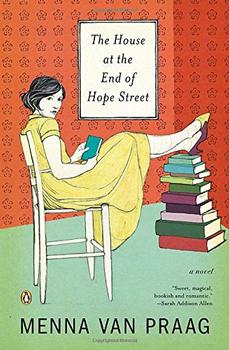Summary | Excerpt | Reviews | Beyond the book | Read-Alikes | Genres & Themes | Author Bio

The Twistrose Key by Norwegian first-time novelist, Tone Almhjell, has plenty of ingredients to capture a middle-grade child's imagination: talking pets, a magical world tucked away in the basement, and a boy made of ice who keeps his soul in a snow globe. It's a relief to discover that Lin, unlike most fantasy-novel heroines, still has both her parents - and they seem particularly wise and sensitive.
Lin's mother named her 'Lindelin' after a heroine in an old folk song, and has taught her how to interpret the multiple meanings in folklore ("gold doesn't always mean gold."). Lin's father encourages her to sharpen her intellect with riddles and quizzes, challenging her to "bring your brain to the party." These are skills that come in handy for a heroine. Long after the parents have faded out of the action, their words continue to guide her in tough situations.
At the beginning, Lin is grieving for her pet, Rufus, a tiny redbacked vole she rescued from the mountains near her old home. Now she's had to move to a rented house in town, and Rufus has died. Lin spends a lot of time mooning around by his grave under a rosebush. When a mysterious key arrives in the mail, Lin uses it to open a magical door in the roots of the rosebush, and enters an icy wilderness.
Waiting for her on the other side is Rufus, grown to human size and walking on two legs. He has crossed over to the Sylver Valley to live among the Petlings, a race of humanoid animals who were once beloved pets belonging to children. According to the rules of Sylver, whenever the Petlings are in dire need, they call in a human child – a Twistrose – for help. This is where Lin comes in. She embarks on a one-night quest to find a missing ice-boy, Isvan Winterfryst, and on the way faces one crisis after another as rogue Petlings try to stop her.
While the elements of Sylver grow out of children's imaginations, the cosmology of Almhjell's fantasy world hugs the boundary between awe-inspiring and convoluted. For example, the moniker "Twistrose" is something Lin herself invented, a code name in an ongoing game she plays about hunting trolls. But in Sylver, by some confusing cosmic wrinkle, Twistroses are actual historical personages; statues of famous Twistroses past are tucked away all over town. So it appears that even the trolls from Lin's game turn out to be real in this place, and the potions she mixed up out of acorns and nettles are actually magic.
This weird circularity almost works, but can seem bewildering if you think about it too much. It's also easy to get lost. The author has crammed an abundance of details and characters into a space so small, that the plot can't blossom fully. When the new characters and settings start coming fast and furious (An owl with a sinister fabricating Machine! A Nightmare from outside the magic hedge around Sylver!) it becomes difficult for the reader to stay emotionally invested in what happens. The Twistrose Key has the flavor, at times, of a child's dream, recounted over the breakfast table. The inventiveness is breathtaking, but threatens to get carried away.
Still, there are beautiful moments that serve to ground the story as it hurtles by. A cozy scene in a mouthwatering restaurant, The Waffleheart, sticks to the ribs, full of delectable details: "A counter ran along the back, heaped with jars of fresh strawberries, raspberry jam, golden treacle, and sugar." Some of Almhjell's lyrical descriptions are as bright and detailed as tiny diorama landscapes. When Lin gets her first glimpse of Sylveros she sees "a large town spread out on the shore of a lake like a rumpled quilt of lights." The winter scenes – snowy streets, frozen woods, and ice caves – are bracingly vivid. Here Lin and Rufus enter a cleft in a mountain: "Far above, the wind gnawed at the rim of the valley, blowing a veil of snow crystals over the edge." The place names themselves – Eversnow Square, The Burning Bird, Cracklemoor, Peppersnap Nook – are poetic and memorable. Lovely maps and illustrations by Ian Schoenherr help the reader stay oriented.
Even if adult readers might be tempted to sneak it off the kids' bookshelves, The Twistrose Key might best be appreciated by children, its intended audience. Young readers are likely to invest in the complicated turnings of the plot, and to not sweat the details of how it all hangs together. The concept of a world of Petlings is sure to appeal, and Tone Almhjell's ornate vision of that world will leave children with many sparkling images to take into their own dreams.
![]() This review was originally published in The BookBrowse Review in January 2014, and has been updated for the
September 2014 edition.
Click here to go to this issue.
This review was originally published in The BookBrowse Review in January 2014, and has been updated for the
September 2014 edition.
Click here to go to this issue.

If you liked The Twistrose Key, try these:

by Adina Rishe Gewirtz
Published 2014
In an extraordinary debut novel, an escaped fugitive upends everything two siblings think they know about their family, their past, and themselves.

The House at the End of Hope Street
by Menna van Praag
Published 2014
Filled with a colorful and unforgettable cast of literary figures, The House at the End of Hope Street is a charming, whimsical novel of hope and feminine wisdom.
Your guide toexceptional books
BookBrowse seeks out and recommends the best in contemporary fiction and nonfiction—books that not only engage and entertain but also deepen our understanding of ourselves and the world around us.